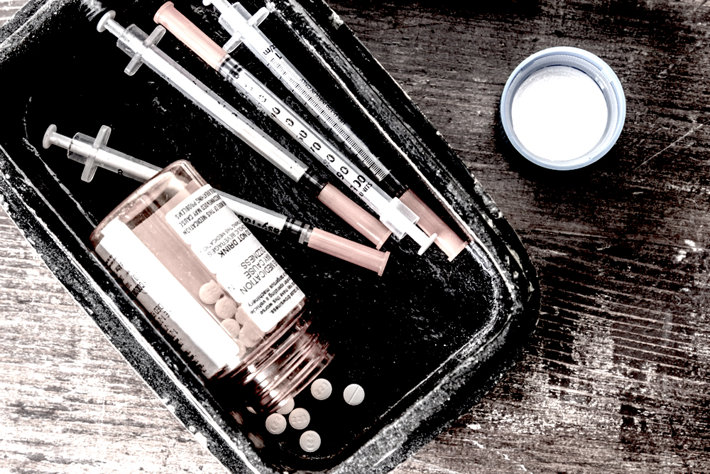Heroin Today

Addiction problems with heroin are old news–or are they? Heroin and its precursor, opium, have been plagues in this country for more than a hundred years. It is thought that the Chinese working on the first transcontinental railroads brought opium from the East with them. Plus it was being used medically as a remedy for a wide variety of complaints, from pain to insomnia to “women’s complaints.”
In the US, heroin addiction was epidemic in the mid-twentieth century, and methadone was developed as a way to reduce overdoses and the spread of disease. While it did reduce some of the harm being done by heroin addiction, it was always known that it was not a complete solution.
Heroin, cocaine and marijuana were the chief drugs of abuse for many years, but then, gradually, prescription drugs crept in to stake out their territory. At first it was tranquilizers, sleeping pills and speed that were mostly abused. Then opioid pain relievers began to be widely prescribed. This meant that there was an enormous supply of opiates flowing through the society and that meant that there was plenty to be diverted through fraud or theft.
As prescription drug abuse gradually increased, heroin continued to be popular in large East Coast cities where there were long-established drug trafficking channels and ethnic groups accustomed to providing the drug to customers. In other parts of the country, the pattern was different. Methamphetamine distribution was strong on the West Coast and powder cocaine was heavily used wherever there was affluence. Crack cocaine abuse increased to become a serious threat in cities, alongside heroin.
Prescription Opiates Change Everything

But especially after the new millennium, prescription drug abuse finally hit seriously damaging levels. Overdoses and emergency room visits began to climb. Between 2004 and 2009, the number of people requiring emergency room help for prescription drug abuse almost doubled, hitting 1.24 million people. Opiates were a large proportion of these visits.
As prescription opiates began to be more popular, especially among white suburban youth, heroin use declined. But also as the problems with prescription opiates grew greater and greater, with more and more overdoses and increasing treatment demand, state governments began to look for ways to solve the problem. They began to make changes in the laws that made prescription drug abuse more difficult.
As state after state made these changes, certain states became “safe havens” for those wishing to get prescription drugs, especially opiates like hydrocodone and oxycodone, to abuse. Florida was the safe haven for a few years, with people flying in from Kentucky and Tennessee to get drugs that they would then take back home to sell.
In 2011, Florida finally got its legislation changed and oxycodone (OxyContin) sales in the state plummeted. Florida joined states like Arkansas and Mississippi who had changed the laws to help dam up the illicit supply of opiates. The “natural” progression for those who either had a taste for opiates or an addiction to them was to switch to heroin.
For years, people had been using heroin if they ran short on money for prescription opiates as heroin was ordinarily less expensive. In some locations, a tenth of a gram of heroin will cost $20 but an OxyContin pill will cost $60 to $80. But as the dosage of heroin is never controlled, it is also more prone to cause overdoses.
City After City Discovers Increasing Heroin Abuse

Take Hamilton County in Kentucky; between 2007 and 2011, their heroin prosecution rate increased 131%. Heroin abuse in Kentucky is focused mostly in three counties: Boone, Kenton and Campbell counties. This combined area comprises 8.5% of the state’s population but has 62% of the first-time heroin offenses. Kenton County had 47 first-time heroin offenses in 2005, but 339 last year.
In nearby Cincinnati, there’s been a 900% increase in the amount of heroin confiscated between 2010 and 2011. A similar trend is being reported by the Chicago Tribune who ran a story in March 2012 on the increase of heroin deaths in the suburbs. And in Central Michigan, increases in heroin abuse were seen in Ionia, Montcalm, Newagyo and Mecosta Counties. In San Diego, the news media reported that the need for treatment of heroin addiction was increasing, as 219 young people had been admitted to treatment in 2007 and 721 were admitted in 2011.
Treatment Options May Not Seek Sobriety as a Result
For the person addicted to opiates, there are plenty of treatment options but many of them do not seek to return the addicted person to full sobriety. They only seek to reduce the harm and improve the overall quality of life by providing pharmaceutical grade opiates to replace street opiates. Or for the person who was addicted to prescription opiates, they allow the person to begin living a crime-free life, an improvement but not a solution to addiction. These are the programs that use methadone or buprenorphine, themselves opioid drugs that prevent withdrawal symptoms and cravings because they provide steady, controlled dosages of opioid drugs every day.
Yes, the addicted person is less troubled by needing to find his drugs every day and doing whatever it takes, including crime, to get them. But he or she is still dependent on a drug and will not, in this way, recover from addiction.
Recovery from addiction means being able to face life without being drugged. It means being able to make decisions that lead away from drugs and toward a productive, goal-oriented life. It ideally means having a solution that reduces or eliminates cravings so every day is not a battle to stay sober.

These are the results that are provided by the Narconon drug and alcohol rehabilitation program. In some forty locations around the world, addicts learn to leave drugs behind in favor of productive, drug-free lives. The Narconon program is an eight to ten week, on average, drug-free program, that teaches life skills for sober living, and has a healthy way of helping those in recovery experience lower or no cravings.
Resources:
- http://www.drugabuse.gov/publications/infofacts/drug-related-hospital-emergency-room-visits
- https://www.drugabuse.gov/
- http://www.mlive.com/news/grand-rapids/index.ssf/2012/03/drug_enforcement_team_makes_ar.html
- http://www.10news.com/news/30641148/detail.html
- http://www.nytimes.com/2011/09/01/us/01drugs.html?pagewanted=all
- http://www.usatoday.com/news/nation/story/2011-10-13/pill-mill-drug-trafficking/50896242/1
- http://www.drugabuse.gov/publications/infofacts/heroin
- http://www.drugabuse.gov/drugs-abuse/heroin
- http://en.wikipedia.org/wiki/Opium
 ®
®